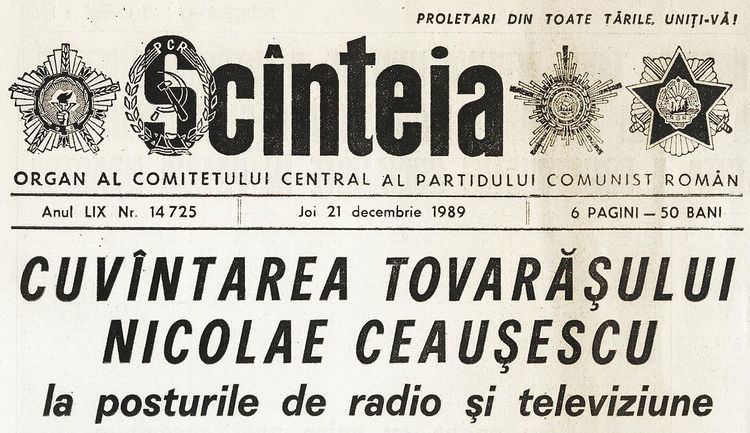 | ||
Scînteia ("The Spark"; the initial spelling of the name in Romanian was Scânteia until the change of the orthography in 1953, as it would have been again, the orthography having officially reverted in 1993) was the name of two newspapers edited by Communist groups at different intervals in Romanian history. The title was a borrowing from the Russian Iskra.
Contents
History
The first paper of that name was edited by Romanian revolutionaries in Bolshevist Russia, appearing throughout 1919 in the city of Odessa.
Scînteia reemerged as the official voice of the Communist Party of Romania on August 15, 1931, being published clandestinely in Bucharest until 1940 (when the hostility between Romania and the Soviet Union grew to a level where a crackdown on communist propaganda became imminent).
With Romania withdrawing from the Axis and joining the Allies in August 1944, Scînteia was yet again being published, to remain the approved, sanctioning, body of communist politics. During Communist Romania (since early 1948), it was the barometer of policy changes, and the main medium through which the regime indicated its aims (for example, Scînteia served as the tribune for slander campaigns against intellectuals such as Tudor Arghezi). Moreover, (indicative of the relations between the official voice and other media), in 1961, August 15 was declared the Romanian Press Day.
The headquarters of the paper were the main feature of the Socialist Realist Combinatul Poligrafic Casa Scînteii "I.V.Stalin", a name later reduced to Casa Scînteii, after it dropped the reference to Joseph Stalin during the De-Stalinization in Romania. Today, the building goes by the name Casa Presei Libere ("The House of the Free Press").
Scînteia was accompanied by a youth version, one edited by the Union of Communist Youth (a branch of the Party that resembled the Soviet Komsomol up to a point). Scînteia Tineretului (or Scânteia tineretului; approximately "Youth's Spark") began its edition in November 1944. It was also published under the names of Tinerețea ("The Youth") and Tînărul Muncitor (or Tânărul Muncitor; "The Young Worker").
With the Romanian Revolution came the outlawing of all Communist Party institutions, including all its newspapers. Scînteia's assets were mostly taken over by the post-communist Adevărul.
